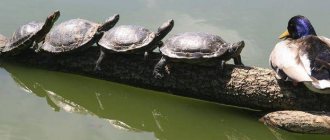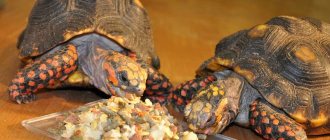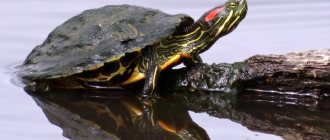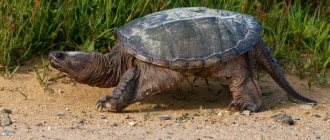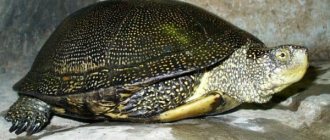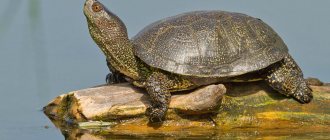Any living creatures, including turtles, have their own instincts. Among all the main instincts, the main one can be distinguished - this is the instinct of procreation. Regardless of where the turtle is in nature or in captivity, this instinct is equally effective. Turtles regularly lay eggs, including unfertilized ones. They are called "diet".
How can you tell if a red-eared slider is hibernating or dead?
The fact that a turtle should hibernate can be determined by the following external signs: the turtle moves little and, at the same time, yawns often. She can hide in a corner of the aquarium and remain motionless there for a long time.
Interesting materials:
How much is the metro fare? How long will ceramic veneers last? How long will polyurethane foam last? How many protons does protium have? How many protons are there in a nitrogen atom? How much interest does Ozon take? How many Rakats are there in Maghrib prayer? How many narrators are there in the Decameron? How long does it take to investigate a minor accident? How long does a rainbow trout grow?
At what age can pregnancy begin?
In natural habitats, red-eared turtles reach sexual maturity at 6-8 years of age. At home, the process of puberty occurs faster, males become sexually mature at 3-4 years, and females at 5-6 years. The ideal age for breeding aquatic reptiles at home is 5 years; earlier attempts to produce offspring will be unsuccessful.
It is quite problematic to accurately determine the age of exotic animals, so for mating it is recommended to select individuals according to the length of their shell. Sexually mature males have a shell of at least 11 cm, females by this age already reach 15-17 cm. Before puberty, it is almost impossible to distinguish the sex of animals; all reptiles look like females.
Secondary sexual characteristics in red-eared turtles can be determined by comparing several individuals. Males are distinguished by a smaller elongated shell, an elongated tail and the presence of sharp long claws on the forelimbs. In addition, the characteristic gender of males is a triangular notch in the terminal part of the abdomen. Males during bathing sometimes release their penis, which looks like a rose flower. After determining age and gender, you can form heterosexual groups of females and males at a ratio of 2:1 and wait for mating games to begin.
Baby care
Little turtles, despite their tiny size, are already fully grown and independent. Young reptiles will need their own room. After 5-7 days, land turtles are taken out of the incubator and moved into a small terrarium, at the bottom of which special soil should be placed: sawdust, peat or gravel. The air temperature is maintained at 30-32C using a fluorescent lamp. A prerequisite is the installation of an ultraviolet radiation source for reptiles with a power of 10% UVB and a special drinking bowl.
Before moving babies into their own home, they must be bathed in boiled water at a temperature of +36C for 30-40 minutes. The volume of water should reach 2/3 of the turtles’ body height. Don’t be alarmed if foolish little ones dip their heads under the water and blow bubbles; wild relatives behave exactly the same way. Water procedures saturate the body of the cubs with the necessary moisture and stimulate intestinal motility of newborn pets. At first, babies need to be bathed 2-3 times a week.
Caring for newborn red-eared slider turtles is necessary in compliance with the principles of caring for adults. After birth, babies do not yet know how to swim, so owners should observe the behavior of the babies in the first hours of their life in the aquarium. For young freshwater turtle reptiles, it is also necessary to equip their own home. For 10-20 turtles, one aquarium with a capacity of 100 liters is enough; the volume of water must be increased gradually as the kids get used to living in an aquatic environment.
The water temperature for young freshwater reptiles should be at least 28-30C. The aquarium must be equipped with banks and islands so that kids always have the opportunity to relax and warm up. A prerequisite for the proper development of the young is the installation of a daytime and ultraviolet lamp for reptiles with a power of 5% UVB.
The body of newborn turtles is very sensitive to infectious microflora that multiply in warm water. From the first days of life, an aquarium for red-eared turtles should be equipped with a filtration system. If it is not possible to install a filter, it is recommended to completely change the water for babies every 1.5-2 days. The aquarium should be filled with settled fresh water at exactly the same temperature in which newborn red-eared turtles usually live.
Article on the topic: Can guinea pigs eat tomatoes and cucumbers? Do they eat them?
Signs
Unfortunately, there are no external signs of pregnancy in reptiles. A pregnant red-eared turtle looks exactly the same as all other turtles. Most often, pregnancy of freshwater turtles in the wild occurs in the spring and summer. At home, reptiles mate most often in the spring in April-May after a long winter hibernation. During this period, it is recommended to carefully monitor the aquatic turtles so as not to miss the courtship process.
Mating games of red-eared turtles are manifested by the active courtship of the male with the female he likes. The boy swims in front of the girl with his tail first and gently tickles the cheeks of the chosen one with the long claws of his front paws. On land, males can approach females and hit the female’s back with their shell. When several different-sex red-eared turtles are kept at the same time, males can start bloody battles for the right to court the female. In this case, it is recommended to leave a group of several girls and one boy.
It is almost impossible to find out that a red-eared turtle is pregnant, but you can suspect a successful conception in a female if you can notice mating games and the process of copulation of reptiles. Mating of red-eared turtles occurs in water and lasts from 5 to 15 minutes; during sexual intercourse, the male tightly hugs the female from behind. Sperm can remain active in the female genital tract for up to 2 years. One sexual intercourse is enough for a female to lay eggs 4-5 times.
You can understand that a red-eared turtle is pregnant by the characteristic behavior of the expectant mother. When a reptile carries eggs in itself, it experiences a change in appetite: from its increase to a complete refusal of food closer to the date of birth. Immediately before laying eggs, the aquatic turtle becomes restless, begins to dig the soil, and circles on land in search of a good place for its nest.
The most accurate confirmation of a reptile’s pregnancy is an x-ray examination, with which you can reliably verify the presence of eggs in the female’s genitals.
The pregnancy of a red-eared slider lasts on average 60 days and ends with the laying of eggs. It is recommended that the expectant mother be separated from the male after mating in order to avoid harm to the health of the female and her future cubs. During pregnancy, turtles must be fed a variety of foods, the bulk of the diet should be animal feed rich in calcium.
Use as food
For culinary needs, only eggs of aquatic turtles (and only certain species) are used. This product can be recognized by its soft shell and perfect spherical shape.
As a rule, this delicacy is part of oriental cuisine, and also serves as a traditional product for residents of Malaysia, Cuba, Costa Rica, and many island residents. They consume the product raw or lightly cooked with the addition of soy sauce. The turtle delicacy tastes like chicken eggs, but leaves behind a musky aftertaste.
The threat of complete extinction of some species of turtles, especially sea turtles, has become the reason for the ban on the consumption and sale of eggs of “wild” reptiles. Instead, the local population and tourists are offered a product from turtle farms. Although poachers are always ready to offer visitors the “forbidden fruit.”
Green turtle nutrition
Having barely seen the light, the turtles, obeying ancient instincts, strive as far into the depths as possible. It is there, among corals, sea reefs, and a variety of algae, that they are threatened by a minimal number of land and water inhabitants trying to eat them. Their increased growth forces them to consume not only vegetation, but also mollusks, jellyfish, and crustaceans. Young green turtles and worms readily eat.
After 7-10 years, the soft shell hardens, and it becomes increasingly difficult for both birds and many predatory fish to get to the tasty meat. Therefore, without fear, turtles rush closer and closer to the shore, to sun-warmed water and a variety of vegetation, not only aquatic, but also coastal. By the time green turtles become sexually mature, they completely switch to plant foods, and remain vegetarians until old age.
Turtles are especially fond of Thalassia and Zostera, whose dense thickets at a depth of 10 meters are often called pastures. Reptiles do not refuse kelp either. They can be found close to the shore during high tide, happily consuming succulent terrestrial vegetation.
Return to content
Smart and prudent
There are many people who are convinced that turtles are not only slow, sluggish creatures, but also stupid. However, this is also not true. Professor Leonid Viktorovich Krushinsky conducted experiments, as far as I know, the only ones in the world that proved that turtles have a mind, that they are capable of thinking. In addition to turtles, a variety of birds and animals took part in the experiments. They were all given the same logic problem. They all had to figure out: where did the food go? The first turtle, like the others later, was brought into the room and left near the feeder. The turtle approached her and began to eat. But a few minutes passed, and the feeder began to slowly move along the rail to the left. The turtle followed her. And then the unexpected happened - the delicacy disappeared from her field of vision: the feeder disappeared behind a wooden screen. Now everything depended on the mental abilities of the turtle. To continue breakfast, she had to figure out which direction the food was going. Pigeons and voles, which were offered this problem earlier than the turtle, were unable to solve it. The rabbits, deprived of food, jumped, not knowing where. The chickens were looking for the grains they had just pecked where they had disappeared. And the ducks, looking for food, tried to get to it through the wooden screen, not realizing that this was impossible. Unlike all of them, the turtle walked along the screen to the left and continued breakfast. The experiments involved both land-living and water-dwelling turtles—European marsh and Caspian turtles. And they all coped with the task perfectly. Other facts also speak about the intelligence of turtles. Turtles that live in the desert, in particular gophers (but not all, but only some of them), after small, rare rains, make pools in which the water can stay for even six hours. Recently, there have been fewer places suitable for laying eggs, and swamp turtles have begun to lay eggs in alligator nests. In these nests, clutches of turtles are less likely to die from predators. Turtles, once in captivity, quickly adapt to new conditions. They stop being afraid of a person and take food from his hands. If they are fed at the same hours and in the same place, they will come there at the right time. Some owners are convinced that their turtles know their names.
Where are turtle eggs used?
The rare product has several areas of application. The most famous is the preparation of delicacies from it or with its inclusion.
In medicine
The product is used in oriental medicine. On its basis, medicines are prepared that are indicated for use in identifying problems with blood circulation and exhaustion. Medicines will also help with stress and depression.
In cooking
Where turtle eggs are supplied regularly, thanks to farms, the hatching product is included in various dishes. They are boiled, baked, pickled. They are used to prepare various desserts, first courses, pastries, omelettes, and snacks.
In which countries is the product eaten?
Reptile eggs have become a national dish in Malaysian cuisine. Atlantic islanders eat them baked over a fire in bamboo leaves. Coastal tribes melt oil from them, which they then use for food. Cuban cafes often serve baked turtle eggs. They also make delicious baked goods.
Since it is almost impossible to order such a delicacy in European restaurants, not to mention buying it at the market or in a store, you can only get acquainted with this unusual dish during a tour to Malaysia or Cuba.
Nuances of preparation
Due to the gelatinous structure of the protein, it will take longer to prepare reptile eggs in a frying pan compared to quail or chicken eggs.
The product owes this characteristic to the thousand-year evolution of reptiles that have adapted to survive in extreme conditions. They live mainly in latitudes with hot climates, laying their offspring in hot sand.
Under similar conditions, the embryos of other living beings would die from the heat. But nature made sure that reptile eggs have increased heat resistance and adaptability. If you cook a product in a shell, it will take a lot of time - even more than when frying.
Turtle eggs are valuable. Together with them, a person receives the necessary nutrients. However, the consumption of turtle eggs can cause the complete extinction of the species very quickly, since the first laying of offspring occurs in reptiles after they reach at least 30 years of age.
Conditions for mating
Reproduction of the red-eared turtle is possible subject to the optimal age for mating - individuals must be young, but at the same time have reached sexual maturity. The readiness of females to reproduce is observed at the age of five, males begin to give birth to offspring in the fifth year of life. If you keep more than two turtles at the same time, it is advisable that there is only one male among them, otherwise the males will fight for the opportunity to mate, causing injury to each other.
Pond slider
Preparation
Getting red-eared turtles to breed in captivity is quite a difficult task. To achieve the desired result, you first need to take care of your pets’ diet. Reptile food should include vitamins and nutrients. Vitamin E is especially useful for males, as it has a positive effect on the reproductive function of animals. Calcium and phosphorus are useful for the normal course of pregnancy in females.
Before the intended mating, two turtles need to be placed in different aquariums. To create a suitable environment, it is recommended to change the water and heat it to 25 o C. It happens that during the mating process, the male does not allow the female to come to the surface for a long time. To prevent the reptile from suffocating, the water level in the aquarium should not exceed 10 centimeters. A container with sand must be placed inside the vessel, where the female will lay eggs.
It should be located in a dry area that is easily accessible to the turtle. Please note that mating will only occur if there is soil in the aquarium. A sign indicating that the female is ready to reproduce is the reptile displaying high activity, as well as its refusal to eat.
Reproduction of sea and land turtles at home and in the wild
Everyone's favorite turtles are one of the most ancient animals on Earth. In nature, turtles reproduce naturally, laying several hundred eggs per season. Reptiles have been kept in homes as pets for quite some time, but not every owner succeeds in raising turtles at home. The reason for this phenomenon is a lack of knowledge of the physiology of unusual animals, an unbalanced diet and violation of feeding and housing conditions. But with a competent approach to the process of breeding turtles in captivity, even beginners can get tiny, cute reptiles.
How many days do chicks hatch?
A budgerigar incubates a clutch for three weeks. Periodically turn each egg so that the embryos develop evenly. The female occasionally leaves the clutch to drink and satisfy her hunger, as well as to empty her intestines. The eggs do not have time to cool to a critical temperature.
Note: it happens that the female abandons the nest and the eggs cool down. If your goal is to breed parrots, give eggs to other hens or try hatching chicks in an incubator.
There may be a difference of several days between the first and last chick, based on the order in which the eggs are laid. When the youngest chick just breaks through the shell, its older brothers have already acquired fluff and gained strength. Natural selection manifests itself - the survival of the fittest.
The female supplies the helpless chicks with crop milk and keeps them warm. The male does not distance himself from the family; he feeds the female while she is sitting on the nest, and then the newborns. Most budgies are caring parents. They feed the chicks for one or two months, until the offspring wants to fly out of the nest.
Young animals must be forcibly separated from their parents at the age of one month. At the same time, the nest is removed, otherwise the married couple will again have a desire to reproduce. The female’s body, weakened by pregnancy, childbirth and feeding, needs rest.
What do newborn turtles look like?
A baby red-eared turtle at birth has a body size of 2.5-3 cm, a baby Central Asian turtle is born about 3-3.5 cm in length. If there were 2 embryos in one egg, the size and weight of the twins will be several times less than that of their brothers.
Article on the topic: Red-eared turtle eggs, how to determine pregnancy and what to do if the turtle laid an egg
Turtle eggs hatch into small turtles with a round body shape that resembles the silhouette of an egg. An adult turtle and its young differ from each other only in body size. Newborn babies, immediately after birth, are fully prepared for independent existence and do not need maternal care.
The birth of turtles is accompanied by a large loss of energy, and newborns will begin to feed in a few weeks or even months. The offspring of turtles are born with a yolk sac on their stomach, thanks to which the babies can go without food for quite a long time. The yolk sac is the size of a cherry and is yellow in color; some baby red-eared turtles literally hug their bright bladder. It is prohibited to tear or forcefully release a baby turtle from its yolk sac; these manipulations can kill the newborn reptile.
Within 2-5 days the bubble will heal on its own. If turtles are born at home, to avoid damage to the yolk sac, you can bandage it to the underside of the shell with a gauze pad. Once the bubble has resolved, the gauze can be removed. Turtles are born with a transverse fold on the abdomen, which is associated with the position of the embryo in the egg. Within a few days of life, the groove is successfully overgrown.
Incubation by other vertebrates
Fish generally do not incubate eggs. However, some species of mouthbrood eggs are not eaten until they hatch.
Some amphibians hatch their eggs. Female Pacific
(
Pacific salamander eschscholtzii
) curls around a clutch of eggs and massages individual eggs with its pulsating throat.
Some aquatic frogs such as the Suriname toad ( Pip peep
) have sacs in the skin into which the eggs are inserted. Other Neotropical frogs in the family Hemiphractidae also have sacs in which the eggs develop, in some species directly into juvenile frogs and in others into tadpoles, which are then stored in small bodies of water to continue their development. The male Darwin's frog does not carry eggs in its mouth until metamorphosis, and the female stomach brooding frog of Australia ingests the eggs, which develop in the stomach.
Description of turtle egg
Round in shape, painted white. It is characterized by a soft shell. On average, the weight fluctuates around 35 g.
Another feature is the icy and absolutely transparent protein. The yolk is very similar to what you see when breaking chicken eggs. The color may vary from light to bright yellow.
Calories and nutritional value
The product has a rich chemical composition. With a calorie content of 155 kcal (per 100 g), it contains vitamins A, E, D, group B. The composition includes various minerals:
- iron;
- iodine;
- magnesium;
- calcium.
Reptile eggs contain compounds that stimulate bone marrow activity.
Beneficial features
The high content of vitamins and minerals determines the benefits of the product. Vitamin E, which is found in the yolk, is responsible for the beauty of the skin - when consumed systematically, it begins to look radiant. And vitamin A ensures good vision. Other useful qualities:
- reducing the risk of osteoporosis in adults, as well as rickets in children;
- a positive effect on the activity of the body as a whole, but primarily on the nervous system;
- normalization of the functioning of the cardiovascular system;
- strengthening the structure of hair, nails and teeth;
- regulation of blood formation and prevention of blood clots;
- improving the activity of the heart muscle.
When consumed regularly, turtle eggs have a positive effect on metabolism. They improve memory, increase performance, maintaining tone.
Protein promotes cell renewal and strengthens the immune system. The benefits of the product have been proven by a number of studies: after radiation therapy or when receiving a large amount of radiation, it helps the body recover faster.
Danger and contraindications
The product can cause harm if a person has an individual intolerance to the components in the composition. Contraindications may include a period of weight loss and obesity, since the eggs of the red-eared turtle and other species of turtles have a high calorie content.
Determination of gender
To ensure reptiles reproduce at home, it is necessary to find out which sex each turtle belongs to. Obviously, the offspring is the result of the mating of a male and a female.
This is interesting: A female reptile can lay eggs without the participation of a male, but storing them will not give any results, since fertilization in this case was not carried out.
Sexual dimorphism in red-eared turtles appears at one year of age. For comparison, it is recommended to take reptiles of the same age. The distinction between individuals is carried out according to the following criteria:
- body size (females are larger);
- claws on the front paws (in males they are longer);
- tail (longer in males than in females);
- the shape of the lower part of the shell (in females it is flat, in boys it is concave).
Enemies
The most dangerous day is the first day of life for small turtles. Birds of prey, lizards and animals know when it is time for a new generation to emerge and lie in wait for it on the shore.
Only a few manage to escape; there are cases when the entire masonry died without ever reaching the water. If the baby leatherback turtle was able to get to the pond, it begins a measured life.
The main enemy of adult reptiles is humans. Pollution of water bodies, illegal catching of reptiles and the development of the tourism business have significantly affected the number of this species. The reptile often mistakes garbage and plastic for food, nutrition is disrupted and the individual dies.
Corrections
| Patches | Changes |
| Patch 194.0 | |
| Patch 193.0 | |
| Patch 189.0 | |
| Patch 188.1 | |
| Patch 188.0 |
|
| Patch 186.1 |
|
| Patch 186.0 |
|
| Patch 178.0 |
| Azulberry (Seeds)• Amarberry (Seeds) • Interjoberry (Seeds) • Narcoberry (Seeds) • Stimberry (Seeds) • Tintoberry (Seeds) | ||
| Vegetables | Potatoes (Seeds) • Corn (Seeds) • Lemon (Seeds) • Carrots (Seeds) | |
| Other | Rare Mushroom • Rare Flower • Plant X Seeds | |
| Animals | Meat | Rotten Meat • Raw Meat (Roasted, Dried) • Raw Prime Meat (Roasted, Dried) • Raw Lamb (Roasted) |
| Fish | Raw Fish (Fried) • Raw Prime Fish (Fried) | |
| Feces | Small Animal Feces (Medium, Large, Huge) • Human Feces | |
| Eggs | Predators | Allosaurus • Giganotosaurus • Dilophosaurus • Dimetrodon • Carnotaurus • Compy • Oviraptor • Raptor (Tek Raptor) • Sarcosuchus • Spinosaurus • Tyrannosaurus (Tek Tyrannosaurus) • Titanoboa |
| Herbivores | Ankylosaurus • Brontosaurus • Gallimimus • Diplodocus • Carbonemis • Lystrosaurus • Parasaurolophus (Tek Parasaurolophus) • Pachycephalosaurus • Stegosaurus (Tek Stegosaurus) • Triceratops | |
| Winged | Argentavis • Dimorphodon • Dodo • Quetzalcoatlus • Pelagornis • Penguin • Pteranodon • Terror Bird | |
| Arachnida | Araneo • Scorpio | |
| Cooking / Chemistry | Dishes | Battle Tartar • Vegetarian Soup • Creamy Delicacy • Meat Stew • Spicy Berry Infusion • Cactus Brew • Brew of Enlightenment • Custom Consumables • Seared Steak • Bingleberry Soup • Amnesia Tonic • Fria Curry |
| Dino food | Food • Sweet vegetable muffin | |
| Medicine | Drug • Blood Pack • Weak Antidote • Stimulant • Healing Brew • Energy Drink | |
| Chemicals | Dyes • Soap • Insect repellent • Miracle fertilizer | |
| Liquids | Waterskin → Water Bottle (Beer) → Flask | |
| Other | Box of candies |
Lifestyle
Adults are found mainly in the open ocean. These animals are tireless travelers. There are known cases of overcoming a huge distance of 20,000 km. from the USA to Indonesia. The leatherback turtle's tracked journey took 647 days, during which it fed primarily on jellyfish. During the day, the reptile preferred deep waters, and surface waters at night. This strategy allowed the turtle to constantly stay in the layer of water where most of the jellyfish are located, making daily migrations upward in the dark and descending during the day.
It is jellyfish that constitute the main diet of adult reptiles, although they can also prey on other soft-bodied animals - cephalopods and tunicates.
It's scary that trash thrown into the ocean can literally kill a leatherback turtle. She perceives a plastic bag floating in the water as a jellyfish. It is clear that eating garbage will not bring anything good to the animal. It is estimated that one in three turtles eat plastic. Given the limited population of animals, it is scary to imagine the amount of garbage in the world's oceans.
Like all sea turtles, the leatherback begins its life journey by crawling out of the sand of the beach where its mother laid her egg. These first minutes of life are the most dangerous. On the way to the water, young turtles are waited by birds, other reptiles, and some mammals. Those few who were able to get to the saving water have a better chance of survival than those who hesitated on the shore.
What the research showed
Recent research has shown that turtle eggs are effective in preventing atherosclerosis, hypertension, diabetes and other diseases, and also provide anti-aging support. There is twice as much vitamin B2 in these eggs as in chicken eggs, and four times more calcium.
Smoke point: which oil is not recommended for frying (so as not to harm your health)
The first country in the world to vaccinate its entire population against Covid
Traveling around Russia and saving: how to get some money back for your trip
Also, this food contains almost no substances harmful to human health. These are mainly fat, cholesterol and sugar. It can be said that turtle eggs are much better than chicken eggs in terms of nutritional value.
Related species
The leatherback turtle is the only member of the family. This reptile is closely related to other species of sea turtles, perfectly adapted to life in the water. Their forelimbs turned into paddle-like flippers, and their shell acquired a streamlined shape. Sea turtles do not retract their heads under their shells. The females of these reptiles lay huge numbers of eggs.
The Australian green turtle (Chelonia depressa) is found only off the coast of Australia. Reaches a length of 72 to 100 cm and weighs about 70 kg. Its smooth, very flat carapace is oval in shape and olive in color with a yellow-brown border along the edges. This carnivorous turtle is endangered.




